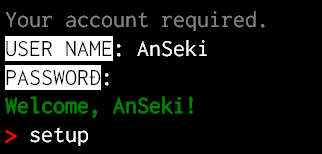6.9 KiB
readlineSync
Synchronous Readline for interactively running.
The interface is used with process.stdin and process.stdout in order to accept user input.
Example
var readlineSync = require('readline-sync');
var userName = readlineSync.question('May I have your name? :'); // Wait for user's response.
var favFood = readlineSync.question('Hi ' + userName + '! What is your favorite food? :');
console.log('Oh, ' + userName + ' likes ' + favFood + '!');
May I have your name? :AnSeki
Hi AnSeki! What is your favorite food? :chocolate
Oh, AnSeki likes chocolate!
Installation
npm install readline-sync
Methods
question
answer = readlineSync.question([query[, options]])
Displays the query to the user, and then returns the user's response after it has been typed.
You can specify options. (see Options)
The query may be string, or may not be (e.g. number, Date, Object, etc.). This is converted to string (i.e. toString method is called) before it is displayed.
prompt
input = readlineSync.prompt([options])
Displays the current prompt (See setPrompt method) to the user, and then returns the user's response after it has been typed.
You can specify options. (see Options)
setPrompt
currentPrompt = readlineSync.setPrompt([newPrompt])
Sets the prompt, for example when you run node on the command line, you see > , which is node's prompt. (See prompt method)
The newPrompt may be string, or may not be (e.g. number, Date, Object, etc.). This is converted to string (i.e. toString method is called) before it is displayed every time.
For example, [foo-directory]# like a bash shell that show the current directory.
// Simple Object that has toString method.
readlineSync.setPrompt({
toString: function() {
return '[' + require('path').basename(process.cwd()) + ']# '; // Get and show current directory.
}
})
setEncoding
currentEncoding = readlineSync.setEncoding([newEncoding])
Set the encoding method of input (user's response) and output (prompt method and question method). Defaults to 'utf8'.
setPrint
readlineSync.setPrint([callback])
The specified callback Function is called when any outputs (prompt method and question method). Defaults to undefined.
The callback is given two arguments the output text and encoding.
For example, this is used to pass plain texts to the Logger, when texts are colored.
var readlineSync = require('readline-sync'),
user, pw, command;
require('colors');
readlineSync.setPrint(function(display, encoding) {
logger.log(display.stripColors); // Remove control characters.
});
console.log('Your account required.'.grey);
user = readlineSync.question('USER NAME'.white.inverse + ': ');
pw = readlineSync.question('PASSWORD'.white.inverse + ': ', {noEchoBack: true});
// Authorization ...
console.log(('Welcome, ' + user + '!').green.bold);
readlineSync.setPrompt('> '.bold.red);
command = readlineSync.prompt();
setBufferSize
currentBufferSize = readlineSync.setBufferSize([newBufferSize])
When readlineSync reads from TTY directly (without reading by shell), a size newBufferSize buffer is used. Even if the user's response exceeds it, it's usually no problem, because the buffer is used repeatedly. But, some platforms's TTY may not accept user's response that is too long. And set a enough size. Defaults to 1024.
Options
An options Object can be specified to prompt method and question method. This Object can have following properties.
noEchoBack
Type: Boolean
Default: false
If true is specified, echo back is avoided. It is used to hide the secret text (e.g. password) which is typed by user on screen.
For example:
password = readlineSync.question('PASSWORD :', {noEchoBack: true});
console.log('Login ...');
The typed text is not shown on screen.
PASSWORD :
Login ...
noTrim
Type: Boolean
Default: false
By default, the leading and trailing white spaces are removed from typed text. If true is specified, those are not removed.
With Task Runner
The easy way to control the flow of task runner by the user's response:
- Grunt plugin: grunt-confirm
- gulp plugin: gulp-confirm
If you want to control the flow of task runner (e.g. Grunt), call readlineSync in a task callback that is called by task runner. Then the flow of tasks is paused and it is controlled by user.
Example: by using grunt-task-helper
$ grunt
Running "fileCopy" task
Files already exist:
file-a.png
file-b.js
Overwrite? (y/n) :y
file-a.png copied.
file-b.js copied.
Done.
Gruntfile.js
grunt.initConfig({
taskHelper: {
fileCopy: {
options: {
handlerByTask: function() {
// Abort the task if user don't want.
return readlineSync.question('Overwrite? (y/n) :')
.toLowerCase() === 'y';
// Or process.exit()
},
filesArray: []
},
...
}
},
copy: {
fileCopy: {
files: '<%= taskHelper.fileCopy.options.filesArray %>'
}
}
});
Note
Platforms
The stdin interfaces are different by platforms. If the platform doesn't support interactively reading from stdin, an error is thrown.
try {
answer = readlineSync.question('What is your favorite food? :');
} catch (e) {
console.error(e);
process.exit(1);
}
Reading by shell
readlineSync tries reading from stdin by shell if it is needed. And if the running Node doesn't support the Synchronous Process Execution (i.e. Node v0.10-), it use "piping via files" for synchronous running.
As everyone knows, "piping via files" is no good. It blocks event loop and a process. It may make your script be slow.
Why did I choose it? :
- The good modules (native addon) for synchronous execution exist. But node-gyp can't compile those in some platforms or Node versions.
- I think that the security is important more than the speed. Some modules have problem about security. (Those don't protect data.) I think that the speed is not needed usually, because readlineSync is used while user types keys.
Release History
- 2015-02-22 v0.6.0 Add
setBufferSize(). - 2015-02-12 v0.5.5 Support the Synchronous Process Execution of Node v0.12(v0.11).
- 2015-01-27 v0.5.0 Add
options.noTrim. - 2014-07-12 v0.4.0 Add
options.noEchoBack. - 2014-07-12 v0.3.0 Add
setPrint(). - 2013-08-30 v0.2.0 Rewrite exporting methods.
- 2013-08-29 v0.1.0 Initial release.
